Specificity versus Functional Training – is there a difference?
 Karen Parnell
January 18, 2022
Karen Parnell
January 18, 2022
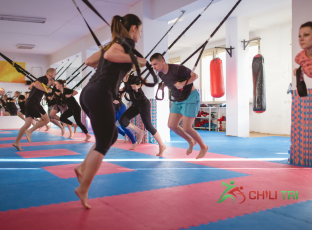
By Karen Parnell 10 minute read
What is the difference between Specificity and Functional Training?
- A discussion with a fellow coach threw up this question, is there a difference between specificity and functional training?
- For a triathlete, apart from cross training and strength & conditioning then an appropriate session could be a swim, bike or run session focussing on progressive overload - training frequency, intensity, time or type (FITT) must be increased over the training period to ensure that the body is pushed beyond its normal rhythm.
- Unilateral training can be considered functional training it attempts to strengthen each half of the body and core to ensure we can produce the power when its needed from a stable core.
- This will be useful for cyclists when they are performing climbs and sprints.
- The swing works your rear chain muscles, core and glutes.
A discussion with a fellow coach threw up this question, is there a difference between specificity and functional training?
As a personal trainer as well as a coach I love functional training for my clients as it helps them become strong and flexible for the demands of everyday life. I use equipment such a ViPRs (long weighted rubber tubes with handles) to mimic three dimensional and loaded movements such as digging, lifting, carrying, chopping etc. I also use kettlebells, Metafit HIIT (High Intensity Interval Training) and suspension trainers for functional fitness but more about that later.
Specificity, as a triathlon coach for me this means swimming, cycling and running and performing these activities at different intensities and durations to improve performance in these areas. The training plan must be relevant to the individual aims, for example training for a Sprint triathlon will be different to training for an IRONMAN.
For a formal definition; Specificity - training must be relevant to the individual and their sport. This can be achieved by tailoring training specifically for the sport or even the position that the individual plays, the muscle groups that they use the most or the dominant energy system of the athlete. For example, a 100m sprinter is likely to train very differently to a 10km runner despite them both being track athletes. The sprinter will focus on speed and power while the distance runner will train for cardiovascular fitness and the ability to work at high intensity aerobically.
So, is there much difference between Specificity and Functional training? The training regime chosen by the fitness professional or coach depends on the aims of the client or athlete. For some clients it important to be strong enough to walk their dog in the mountains or muck out their horses for example. A training session focusing on glutes, quads, calf’s, core and hamstrings using a suspension trainer and kettlebells for walking the dog may be a good idea. For mucking out the horses then mimicking the movement patterns of digging using a ViPR may be appropriate to make appropriate adaptations in the deltoids, biceps/triceps, lats, traps and core muscles may be a way forward.
For a triathlete, apart from cross training and strength & conditioning then an appropriate session could be a swim, bike or run session focussing on progressive overload - training frequency, intensity, time or type (FITT) must be increased over the training period to ensure that the body is pushed beyond its normal rhythm. Increases must be gradual so that the athlete avoids a plateau in performance or, worse, injury.
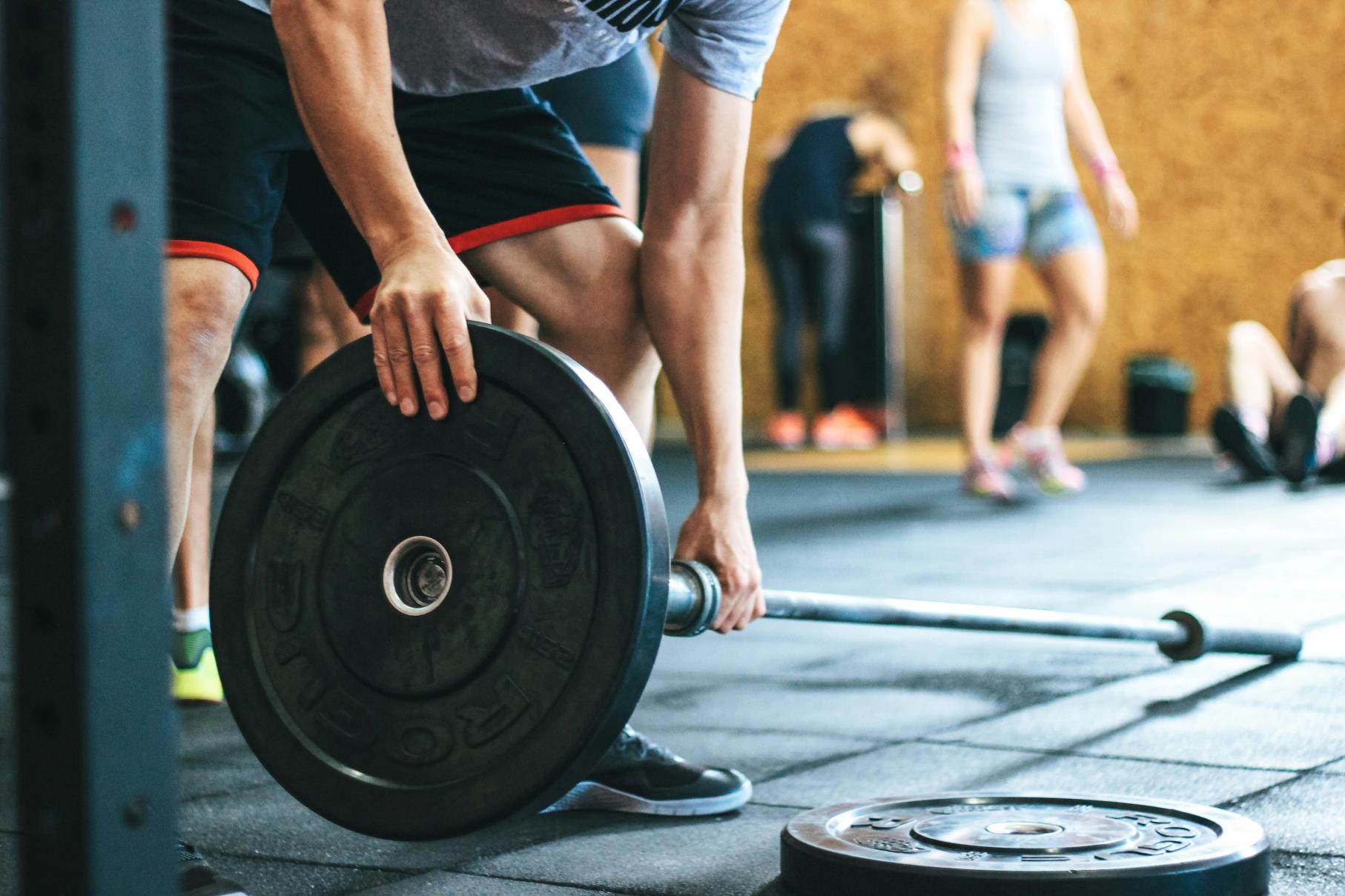
Get your FREE Strength and Conditioning 7-day plan here.
Frequency, Intensity, Time, Type FITT
FITT - (Frequency, Intensity, Time, Type) - Frequency is increased by training a greater number of times each week. Intensity is increased by lifting a greater resistance, such as with weight training, or by training at a higher percentage of maximum heart rate (HR Max). This can be done either as continuous or interval training. Time can be manipulated by training for longer, reducing recovery times or by completing a greater number of sets or repetitions (also known as reps). Type of training is manipulated by offering a variety of training types and experiences to the athlete by combining training methods. Progressive overload is relevant to both Specificity and Functional training.
As I mention in another Blog unilateral training is highly effective for triathletes as with swimming, running and cycling we tend to be using one side of the body as the primary power source at a time. Unilateral training can be considered functional training it attempts to strengthen each half of the body and core to ensure we can produce the power when its needed from a stable core.
Functional Training Equipment
ViPR
ViPR is a rubber, hollow, weighted tube with handles, and it is used for total body training under the concept of “Loaded Movement Training.” ViPR stands for Vitality, Performance and Reconditioning. This tool can be used in any portion of a workout or as entire workouts. It can be used for mobility, strength and conditioning. ViPR can be used for movements that include both the upper and lower body and that simulate a specific task, such as lifting, shifting, dragging and tilting.
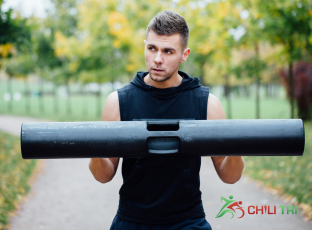
Get your FREE 23-Page Athletes Guide to Strength and Conditioning
Using the ViPR can train your body to perform everyday movements that should be basic and functional in nature. Training with the ViPR can help your body stay in proper form when you’re at home lifting a large basket of laundry, or if you are constantly hoisting large items over your shoulder at a farm.
ViPR differs from other tools such as kettlebells and medicine balls because of the length of the rubber tube. It increases the lever arm of load, which makes the entire body stabilize against the load of the tube. Its shape, material, handles and length also make it easy for users to perform a variety of movements that may not be feasible with kettlebells or medicine balls.
Cycling requires a great deal of power from the legs and glutes. Mixing traditional squat routines with some progressive ViPR lateral shift motions will help cyclists improve muscle activation from the sagittal plane to the frontal plane. This will be useful for cyclists when they are performing climbs and sprints. A great exercise would be the ViPR lateral step with shift.
Get your FREE Strength and Conditioning 7-day plan here.
Suspension Trainer
The term suspension training refers to an approach to strength training that uses a system of ropes and webbing called a “suspension trainer” to allow users to work against their own body weight. TRX is the brand that launched the suspension trainer and you can use the code TRX20CHILITRI to get 20% off at the TRX site.
The field of suspension training is a form of resistance training that includes bodyweight exercises in which a variety of multi-planar, compound exercise movements can be performed. These are done with the aim of developing strength, balance, flexibility, and joint stability simultaneously. Suspension training develops physical strength while using functional movements and dynamic positions.
This versatile piece of kit can be taken on holiday, away on business and when packed into its bag take up very little room. I love using it for both clients and athletes alike as it can mimic movements such as the pull and push phases of the freestyle stroke using a move called the swimmers pull. This movement strengthens the muscles used in the freestyle stroke.
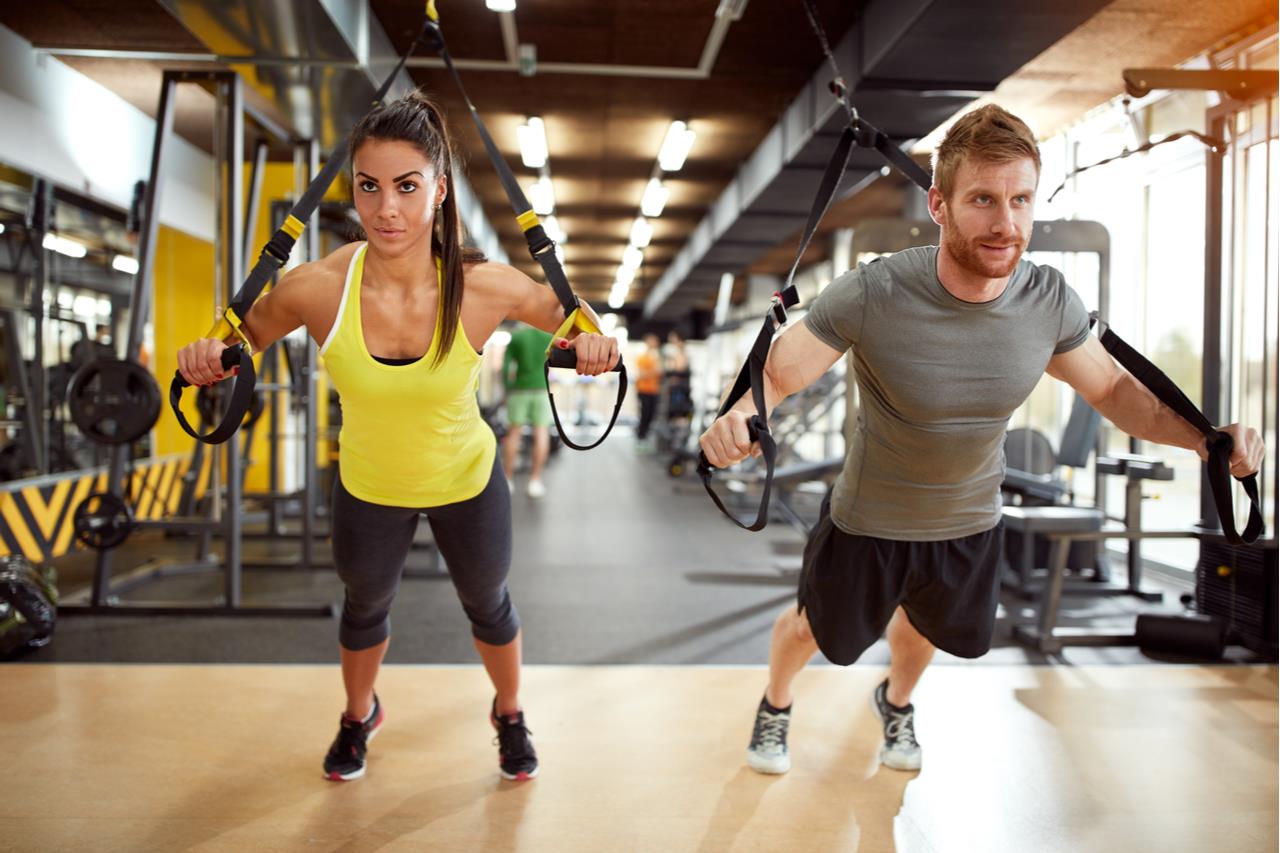
Get your FREE 23-Page Athletes Guide to Strength and Conditioning
Kettlebells
The kettlebell is a cast-iron or cast steel ball with a handle attached to the top (resembling a cannonball with a handle). It is used to perform many types of exercises, including but not limited to ballistic exercises that combines cardiovascular, strength and flexibility training. They are also the primary equipment used in the weightlifting sport of kettlebell lifting.
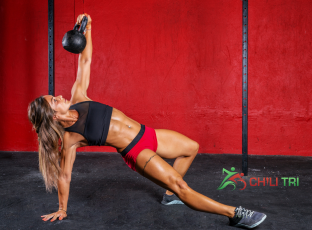
Get your FREE 23-Page Athletes Guide to Strength and Conditioning
In his book Kettle Bell Training, world renowned Kettle Bell expert Steven Cotter describes ‘functional training’ as: “Exercise that addresses the body as a whole system in order to train movements and motor patterns that result in effective movement. Functional fitness programs focus on performance rather than aesthetics”. This requirement for performance or movement not aesthetics is also gaining traction in other publications on human motion and how we evolved as a species of hominid (Forencich, Frank. Play as if your life depends on it: Functional exercise and living for Homo Sapiens. GoAnimal, 2003.).
My favourite exercise is the swing. The swing works your rear chain muscles, core and glutes. Both exercises are equally effective in building power. It great at upper back development, posterior chain and midsection development and strength.
For beginners, it is probably best to focus on building a powerful hip hinge movement before moving on to more advanced moves like the kettlebell snatch. Otherwise, those new to KBs might be more tempted to use the upper body to complete the movement.
Swings are great for waking the glutes up. When done correctly, almost all of the “pop” of a swing comes from a powerful contraction of the glutes. This is important for both runners and cyclists. What’s more, that contraction is initiated from a closed hip angle. A factor that is very relevant for anyone riding in the steep aero position mentioned above.
You can read more about how to train with kettlebells in this Blog.
Metafit HIIT
Metafit is a form of High Intensity Interval Training (HIIT) and has many benefits for clients and athletes alike. It combines strength, functional movements and cardiovascular elements. Activities are performed with full range of movement and/or flat out to enable the EPOC effect. Excess Post exercise Oxygen Consumption (EPOC) is also known as oxygen debt, EPOC is the amount of oxygen required to restore your body to its normal, resting level of metabolic function (called homeostasis). It also explains how your body can continue to burn calories long after you’ve finished your workout.
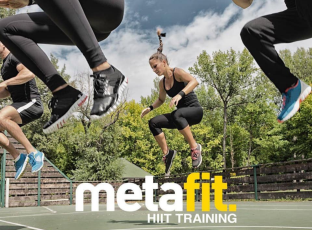
Get your FREE 23-Page Athletes Guide to Strength and Conditioning
Metafit is an all over body workout in an interval training format, intense exercise followed by short rest periods. It combines core exercises such as planks with functional moves like get ups and cardio in the form of exercises like sprints and 2 step dash. I particularly like the get up as is starts with you lying on the floor and you need to get up with minimal or hand to ground touches and ends standing up with a powerful jump. It uses most of your bodies muscle groups and ends with a plyometric jump. Do these a few times and your will be out of breath! Everybody should be able to get up from the ground.
A Metafit main set (i.e., without including warm up, warm down and stretches) is about 20 minutes long. Any longer than 30 minutes and it’s not a HIIT workout as you do need to be working flat out. Working at this intensity level for longer than 30 minutes can lead to injury or simply not working at the level needed to get the benefits of a HIIT workout.
Conclusion: Funcational Training
For triathletes, the use of ViPRs, Kettlebells, Suspension Trainers and Metafit HIIT are all relevant and effective. As long as the movement patterns, intensity level, frequency/repetitions and duration prescribed by the coach or personal trainer are relevant to your specific goals then this will be effective.
For the athlete then specificity training is relevant to the sport you are competing in is also highly effective and proven. For me a blend of functional and specificity is the best as it can also help to avoid injuries by strengthening specific areas of the body that may be susceptible to over training such as the knees, ankles and back.
Get your FREE Strength and Conditioning 7-day plan here.
Karen Parnell is a Level 3 British Triathlon and IRONMAN Certified Coach, 8020 Endurance Certified Coach, WOWSA Level 3 open water swimming coach and NASM Personal Trainer and Sports Technology Writer.
Karen is currently studying for an MSc in Sports Performance Coaching at the University of Stirling.
Need a training plan? I have plans on TrainingPeaks and FinalSurge:
I also coach a very small number of athletes one to one for all triathlon and multi-sport distances, open water swimming events and running races, email me for details and availability. Karen.parnell@chilitri.com
Get your FREE Guide to Running Speed and Technique
Get your FREE Swim Workouts for Triathletes E-book
Get your FREE Open Water Swimming Sessions E-Book
Get your FREE 23-Page Athletes Guide to Strength and Conditioning
What is specificity training?
Specificity training, also known as sport-specific training, involves tailoring your training to closely mimic the movements, demands, and conditions of your target sport. For triathletes, it means focusing on swim, bike, and run disciplines to improve performance in each specific discipline.
What is functional training?
Functional training focuses on exercises and movements that improve overall movement patterns, strength, stability, and mobility. It emphasizes training movements rather than isolating individual muscles and aims to enhance functional fitness for everyday activities and sports performance.
What are the benefits of specificity training for triathletes?
Specificity training offers several benefits for triathletes:
- Sport-specific adaptations: By training specifically for each discipline (swimming, biking, running), you can improve technique, efficiency, and performance in those specific movements.
- Neuromuscular coordination: Specificity training helps develop neuromuscular coordination, allowing the body to efficiently execute the movement patterns required in each sport.
- Energy system development: Focusing on sport-specific training helps target the specific energy systems used during each discipline, improving aerobic capacity, lactate threshold, and endurance in those areas.
- Mental preparation: Specificity training allows triathletes to become familiar with the demands and conditions of each discipline, mentally preparing them for race situations.
What are the benefits of functional training for triathletes?
Functional training provides several benefits for triathletes:
- Injury prevention: Functional training helps improve overall strength, stability, and mobility, reducing the risk of imbalances and injuries caused by repetitive movements.
- Core strength and stability: Many functional exercises engage the core muscles, which are crucial for maintaining proper form and stability during all three disciplines of triathlon.
- Balance and coordination: Functional training enhances balance and coordination, which are essential for navigating uneven terrain, technical courses, and transitions.
- Strength transferability: Functional training can improve overall strength and power, which can translate into improved performance in all three disciplines.
- Efficiency and body awareness: Functional training improves body awareness, movement efficiency, and proprioception, which can enhance technique and efficiency in each discipline.
Can specificity and functional training be combined for triathletes?
Yes, specificity and functional training can be combined to create a well-rounded training program for triathletes. By incorporating sport-specific exercises and drills alongside functional exercises that target overall movement patterns, strength, and stability, athletes can benefit from both approaches. The key is finding the right balance and periodization based on individual needs and training goals.
How should I integrate specificity and functional training into my triathlon training plan?
Consider the following when integrating specificity and functional training:
- Prioritize sport-specific training: Allocate the majority of your training time to sport-specific sessions, focusing on technique, intervals, and race simulations in each discipline.
- Incorporate functional exercises: Include functional exercises 2-3 times per week to address strength imbalances, stability, and mobility. These can be done during cross-training days or as part of warm-ups and cooldowns.
- Periodize your training: Adjust the emphasis on specificity and functional training throughout your training plan based on your competition schedule, individual weaknesses, and the phase of your training (base, build, taper).
Remember, consulting with a qualified coach or trainer can help you design a personalized training program that incorporates both specificity and functional training to maximize your triathlon performance.
References
Specificity in the relationship between training and performance in triathlons - PubMed (nih.gov)
The Application of Specificity: Triathlon and Cycling - Source Endurance (source-e.net)
https://www.trxtraining.com/blogs/news/trx-exercises-for-triathletes
ViPR for sport coaches and athletes (viprfit.com)
#chilitri #functionaltraining #triathlon #kettlebells #trx #suspensiontraining #vipr #swimming #cycling #running #strengthandconditioning #S&C
#triathlontrainingplan #swimmingtrainingplan #cyclingtrainingplan #runningtrainingplan
